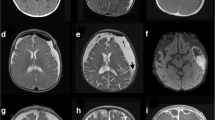Abstract
Object
Subdural hematomas (SDHs) in full-term infants have the potential to cause death or lifelong disability. We report management and outcomes of eight cases of newborn with large SDH treated by streptokinase (SK) lavage and drainage.
Materials and methods
Between 2003 and 2006, eight infants with large acute SDH with focal or diffuse hypodensity showing signs and symptoms of neurological deterioration were treated by drainage and subdural SK lavage. There were eight full-term infants, five boys and three girls, with ages between 10 days and 2 months. Head injuries were shaken baby syndrome in three cases, fall from height in three cases, caused by traffic accident in one case, and reportedly not due to trauma in one case. In all patients, SDHs were unilateral. We used a new surgical approach, SDH evacuation, involving the subdural instillation of SK for lysis and after drainage of acute SDH in infants. Follow-up in the series ranged from 1 to 42 months (average 30 months). There was no mortality in this series, neither in the early postoperative period nor in the follow-up period. Five patients of this series lead a normal life; two children were mildly neurodevelopmentally delayed.
Conclusion
Subdural infusion of SK followed by drainage may be as safe and effective for treatment of acute SDHs in infants as other reported methods.







Similar content being viewed by others
References
Aoki N (1990) Chronic subdural hematoma in infancy. Clinical analysis of 30 cases in the CT era. J Neurosurg 73:201–205
Baker WF (2003) Thrombolytic therapy: clinical applications. Hematol Oncol Clin North Am 17:283–311
Golden N, Maliawan S (2005) Clinical analysis of non-accidental head injury in infants. J Clin Neurosci 12(3):235–239
Hariton GB, Findlay JM, Weir BKA, Kasuya H, Grace MGA, Mielke BW (1993) Comparison of intrathecal administration of urokinase and tissue plasminogen activator on subarachnoid clot and chronic vasospasm in a primate model. Neurosurgery 33:691–697
Hwang SK, Kim SL (2000) Infantile head injury, with special reference to the development of chronic subdural hematoma. Childs Nerv Syst 16:590–594
Jayawant S, Rawlinson A, Gibbon F, Price J, Schulte J, Sharples P, Sibert JR (1998) Subdural haemorrhages in infants: population based study. BMJ 317:1558–1561
Jhawar BS, Ranger A, Steven DA, Del Maestro RF (2005) A follow-up study of infants with intracranial hemorrhage at full-term. Can J Neurol Sci 32:332–339
Kajimoto Y, Ohta T, Kuroiwa T (1997) Comparison of intrathecally administered urokinase, tissue-type plasminogen activator, and combination of urokinase and lysine-plasminogen for clot lysis after experimental subarachnoid hemorrhage in dogs. Neurosurgery 40:572–577
Lee KR, Kawain N, Kim S, Sagher O, Hoff JT (1997) Mechanisms of edema formation after intracerebral hemorrhage: effects of thrombin on cerebral blood flow, blood-brain barrier permeability, and cell survival in a rat model. J Neurosurg 86:272–278
Loh J-K, Lin C-L, Kwan A-L, Howng S-L (2002) Acute subdural hematoma in infancy. Surg Neurol 58:218–224
Miyake H, Kajimoto Y, Ohta T, Kuroiwa T (2002) Managing subdural fluid collection in infants. Childs Nerv Syst 18:500–504
Naff NJ, Williams MA, Rigamonti D, Keyl PM, Hanley DF (2001) Blood clot resolution in human cerebrospinal fluid: evidence of first-order kinetics. Neurosurgery 49:614–621
Perret GE, Graf CJ (1977) Subgaleal shunt for temporary ventricle decompression and subdural drainage. J Neurosurg 47:590–595
Rohde V, Rohde I, Thiex R, Ince A, Jung A, Dückers G, Gröschel K, Röttger C, Küker W, Müller HD, Gilsbach JM (2002) Fibrinolysis therapy achieved with tissue plasminogen activator and aspiration of the liquefied clot after experimental intracerebral hemorrhage: rapid reduction in hematoma volume but intensification of delayed edema formation. J Neurosurg 97:954–962
Romodanov AP, Brodsky YS (1987) Subdural hematomas in the newborn. Surgical treatment and results. Surg Neurol 28:253–258
Shroff M, deVeber G (2003) Sinovenous thrombosis in children. Neuroimaging Clin N Am 13:115–138
Tubbs RS, Smyth MD, Wellons JC III, Blount JP, Grabb PA, Oakes WJ (2003) Alternative uses for the subgaleal shunt in pediatric neurosurgery. Pediatr Neurosurg 39:22–24
Vinchon M, Noule N, Soto-Ares G, Dhellemmes P (2001) Subduroperitoneal drainage for subdural hematomas in infants: results in 244 cases. J Neurosurg 95:249–255
Vinchon M, Noule N, Tchofo PJ, Soto-Ares G, Fourier C, Dhellemmes P (2004) Imaging of head injuries in infants: temporal correlates and forensic implications for the diagnosis of child abuse. J Neurosurg 101(1 Suppl):44–52
Vinchon M, Defoort-Dhellemmes S, Desurmont M, Dhellemmes P (2005) Accidental and nonaccidental head injuries in infants: a prospective study. J Neurosurg 102(4 Suppl):380–384
Vinchon M, Pierrat V, Tchofo PJ, Soto-Ares G, Dhellemmes P (2005) Traumatic intracranial hemorrhage in newborns. Childs Nerv Syst 21:1042–1048
Wagner KR, Xi G, Hua Y, Zuccarello M, de Courten-Myers G, Broderick JP, Brott TG (1999) Ultra-early clot aspiration after lyses with tissue plasminogen activator in a porcine model of intracerebral hemorrhage: edema reduction and blood-brain barrier protection. J Neurosurg 90:491–498
Xi G, Keep RF, Hoff JT (1998) Erythrocytes and delayed brain edema formation following intracerebral hemorrhage in rats. J Neurosurg 89:991–996
Yapicioglu H, Narli N, Satar M, Soyupak S, Altunbasak S (2003) Intraventricular streptokinase for the treatment of posthaemorrhagic hydrocephalus of preterm. J Clin Neurosci 10:297–299
Zouros A, Bhargava AR, Hoskinson M, Aronyk KE (2004) Further characterization of traumatic subdural collections of infancy. Report of five cases. J Neurosurg 100(5 Suppl Pediatrics):512–518
Zuccarello M, Andaluz N, Wagner KR (2002) Minimally invasive therapy for intracerebral hematomas. Neurosurg Clin N Am 13:349–354
Acknowledgments
We greatly appreciate Prof. David B. Shurtleff, Department of Pediatrics, University of Washington and Ali Guermazi, MD, Department of Radiology, Boston University Medical Center for their support and criticism in the writing of this article.
Author information
Authors and Affiliations
Corresponding author
Rights and permissions
About this article
Cite this article
Larionov, S.N., Sorokovikov, V.A. & Novozilov, V.A. Management of acute subdural hematomas in infants: intrathecal infusion streptokinase for clot lysis combined with subdural to subgaleal shunt. Childs Nerv Syst 24, 437–442 (2008). https://doi.org/10.1007/s00381-007-0496-1
Received:
Published:
Issue Date:
DOI: https://doi.org/10.1007/s00381-007-0496-1




